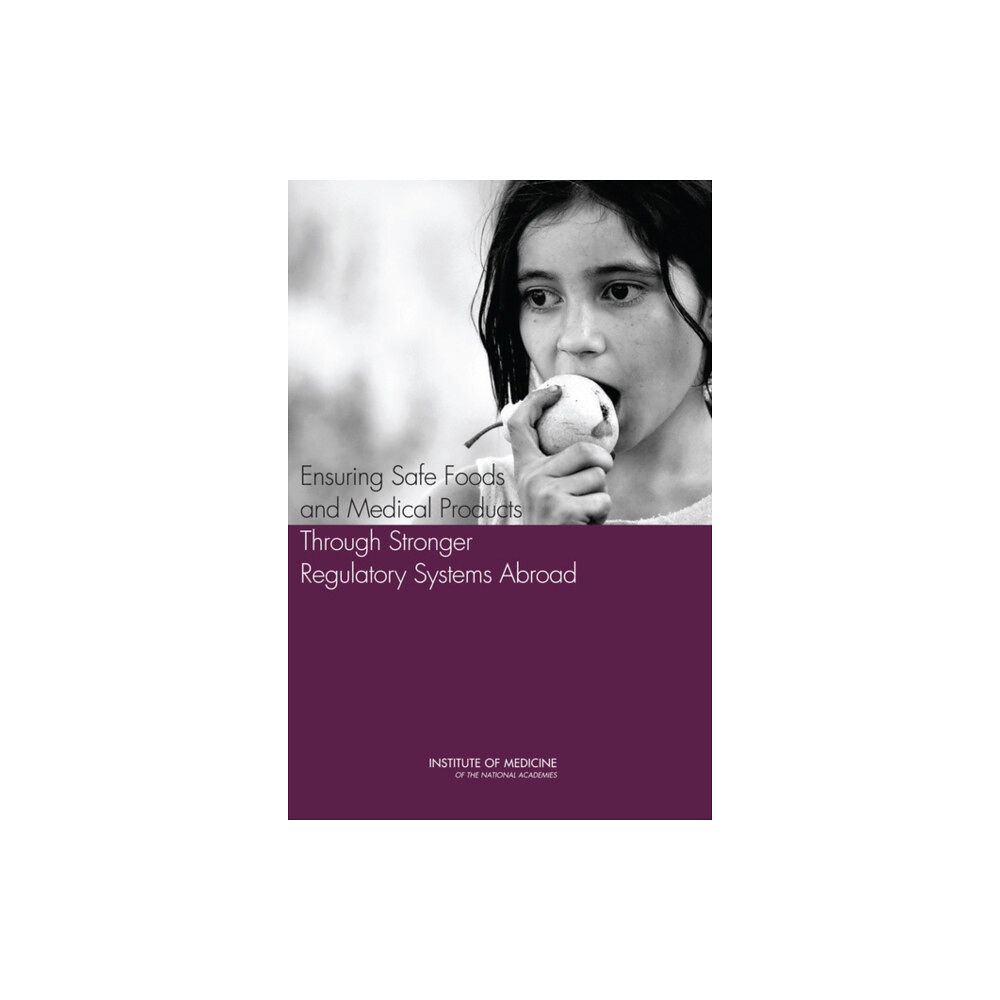- Hem
- Böcker
- Kurslitteratur
- Samhälle & Politik
- Ensuring Safe Foods and Medical Products Through Stronger Regulatory Systems Abroad (häftad, eng)

Ensuring Safe Foods and Medical Products Through Stronger Regulatory Systems Abroad (häftad, eng)
A very high portion of the seafood we eat comes from abroad, mainly from China and Southeast Asia, and most of the active ingredients in med...
709 kr
Bara 2 kvar
Skickas inom 4 - 5 vardagar
- Fri frakt
Just nu: Fri frakt på alla köp
Snabb leverans
Alltid låga priser
Produktbeskrivning
A very high portion of the seafood we eat comes from abroad, mainly from China and Southeast Asia, and most of the active ingredients in medicines we take originate in other countries. Many low- and middle-income countries have lower labor costs and fewer and less stringent environmental regulations than the United States, making them attractive places to produce food and chemical ingredients for export.
Safe Foods and Medical Products Through Stronger Regulatory Systems Abroad explains that the diversity and scale of imports makes it impractical for U.S. Food and Drug Administration (FDA) border inspections to be sufficient to ensure product purity and safety, and incidents such as American deaths due to adulterated heparin imported from China propelled the problem into public awareness.
The Institute of Medicine Committee on Strengthening Core Elements of Regulatory Systems in Developing Countries took up the vital task of helping the FDA to cope with the reality that so much of the food, drugs, biologics, and medical products consumed in the United States originate in countries with less-robust regulatory systems.
Ensuring Safe Foods and Medical Products Through Stronger Regulatory Systems Abroad describes the ways the United States can help strengthen regulatory systems in low and middle income countries and promote cross-border partnerships - including government, industry, and academia - to foster regulatory science and build a core of regulatory professionals.
This report also emphasizes an array of practical approaches to ensure sound regulatory practices in today's interconnected world. Table of ContentsFront MatterSummary1 Introduction2 Core Elements of Regulatory Systems3 Critical Issues4 A Strategy to Building Food and Medical Product Regulatory Systems5 International Action6 Domestic Action7 Conclusions and PrioritiesAppendix A: GlossaryAppendix B: A Review of Tort Liability's Role in Food and Medical Product RegulationAppendix C: Food and Medical Product Regulatory Systems of South Africa, Brazil, India, and ChinaAppendix D: Chinese Food Regulatory SystemAppendix E: Meeting AgendasAppendix F: Committee Member BiographiesAppendix G: Analyzing Food Safety Alerts in European Union Rapid Alerts Systems for Food and FeedAppendix H: Strengthening Core Elements of Regulatory Systems in Developing Countries: Identifying Priorities and an Appropriate Role for the U.S Food and Drug Administration
Safe Foods and Medical Products Through Stronger Regulatory Systems Abroad explains that the diversity and scale of imports makes it impractical for U.S. Food and Drug Administration (FDA) border inspections to be sufficient to ensure product purity and safety, and incidents such as American deaths due to adulterated heparin imported from China propelled the problem into public awareness.
The Institute of Medicine Committee on Strengthening Core Elements of Regulatory Systems in Developing Countries took up the vital task of helping the FDA to cope with the reality that so much of the food, drugs, biologics, and medical products consumed in the United States originate in countries with less-robust regulatory systems.
Ensuring Safe Foods and Medical Products Through Stronger Regulatory Systems Abroad describes the ways the United States can help strengthen regulatory systems in low and middle income countries and promote cross-border partnerships - including government, industry, and academia - to foster regulatory science and build a core of regulatory professionals.
This report also emphasizes an array of practical approaches to ensure sound regulatory practices in today's interconnected world. Table of ContentsFront MatterSummary1 Introduction2 Core Elements of Regulatory Systems3 Critical Issues4 A Strategy to Building Food and Medical Product Regulatory Systems5 International Action6 Domestic Action7 Conclusions and PrioritiesAppendix A: GlossaryAppendix B: A Review of Tort Liability's Role in Food and Medical Product RegulationAppendix C: Food and Medical Product Regulatory Systems of South Africa, Brazil, India, and ChinaAppendix D: Chinese Food Regulatory SystemAppendix E: Meeting AgendasAppendix F: Committee Member BiographiesAppendix G: Analyzing Food Safety Alerts in European Union Rapid Alerts Systems for Food and FeedAppendix H: Strengthening Core Elements of Regulatory Systems in Developing Countries: Identifying Priorities and an Appropriate Role for the U.S Food and Drug Administration
| Format | Häftad |
| Omfång | 366 sidor |
| Språk | Engelska |
| Förlag | National Academies Press |
| Utgivningsdatum | 2012-09-03 |
| ISBN | 9780309224086 |
Specifikation
Böcker
- Format Häftad
- Antal sidor 366
- Språk Engelska
- Utgivningsdatum 2012-09-03
- ISBN 9780309224086
- Förlag National Academies Press
Leverans
Vi erbjuder flera smidiga leveransalternativ beroende på ditt postnummer, såsom Budbee Box, Early Bird, Instabox och DB Schenker. Vid köp över 399 kr är leveransen kostnadsfri, annars tillkommer en fraktavgift från 39 kr. Välj det alternativ som passar dig bäst för en bekväm leverans.
Betalning
Du kan betala tryggt och enkelt via Avarda med flera alternativ: Swish för snabb betalning, kortbetalning med VISA eller MasterCard, faktura med 30 dagars betalningstid, eller konto för flexibel delbetalning.
Specifikation
Böcker
- Format Häftad
- Antal sidor 366
- Språk Engelska
- Utgivningsdatum 2012-09-03
- ISBN 9780309224086
- Förlag National Academies Press
